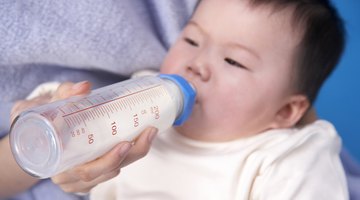Chemicals in Disposable Diapers
Disposable diapers seem to be a necessity in today’s lifestyle of convenience and temporary items.
Though they are commonly used, synthetic, single-use diapers often contain chemicals, such as dioxins, that are linked to long-term health conditions (World Health Organization, 2010).
A study published in the "Archives of Environmental Health" in 1999 states that disposable diapers should be considered to be a factor that may cause or worsen childhood asthma and respiratory problems. The soft, sensitive skin of babies is also prone to rashes and allergic reactions due to the chemicals in disposable diapers.
Dioxins
Most disposable diapers are bleached white with chlorine, (Chemistryexplained.com) resulting in a byproduct called dioxins that leach into the environment and the diapers. According to the U.S. Environmental Protection Agency (EPA), dioxins are among the most toxic chemicals known to science and are listed by the EPA as highly carcinogenic chemicals. According to the World Health Organization, exposure to dioxins may cause skin reactions and altered liver function, as well as impairments to the immune system, nervous system, endocrine system and reproductive functions.
Sodium Polyacrylate

What Can Cause Green Bowel Movements in Infants?
Learn More
Sodium polycarbonate is a super absorbent chemical compound that is used in the fillers of many disposable diapers. It is composed of cellulose processed from trees that is mixed with crystals of polyacrylate. This chemical absorbs fluids and creates surface tension in the lining of the diaper to bind fluids and prevent leakage.
Sodium polyacrylate is often visible as small gel-like crystals on the skin of babies and is thought to be linked to skin irritations and respiratory problems.
This chemical was removed from tampons due to toxic shock syndrome concerns. As it has only been used in diapers for the last two decades, there is not yet research on the long-term health effects of sodium polyacrylate on babies.
Tributyl-tin (TBT)
Many disposable diapers contain a chemical called tributyl-tin (TBT). According to the EPA, this toxic pollutant is extremely harmful to aquatic (water) life and causes endocrine (hormonal) disruptions in aquatic organisms. TBT is a polluting chemical that does not degrade but remains in the environment and in our food chain.
TBT is also an ingredient used in biocides to kill infecting organisms. Additionally, according to research published by the American Institute of Biological Sciences, tributyl-tin can trigger genes that promote the growth of fat cells, causing obesity in humans.
Volatile Organic Compounds (VOCs)

Are Paint Vapors Harmful to Infants?
Learn More
Disposable diapers frequently contain chemicals called volatile organic compounds (VOCs). These include chemicals such as ethylbenzene, toluene, xylene and dipentene.
According to the EPA, VOCs can cause eye, nose and throat irritation, headaches, damage to the liver, kidney and central nervous system. Some VOCs are even suspected of causing cancer in humans (EPA.gov).
Other Chemicals
Other chemicals often used in disposable diapers include dyes, fragrances, plastics and petrolatums. Adhesive chemicals are used in the sticky tabs to close the diapers and dyes are used to color and make the patterns and labels that mark diapers. Perfumes and fragrances are used in some disposable diapers to help mask odors.











